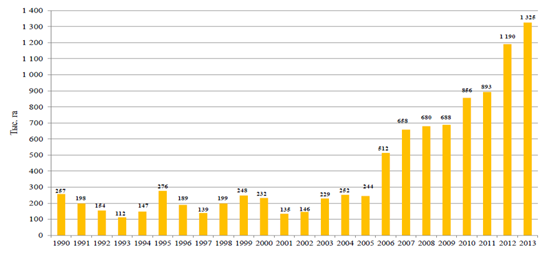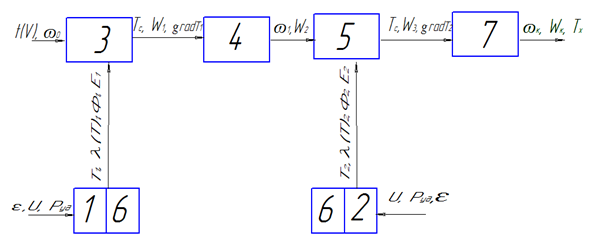СУШКА СЕМЯН РАПИСА ИК-ИЗЛУЧЕНИЕМ
Попов В.М.1, Афонькина В.А.2, Шукшина Е.И.3, Майоров В.И.4
1Доктор тех. наук, 2Старший преподаватель, 3Ассистент, Южно-Уральская Агроинженерная Академия, 4Профессор, Тюменский государственный университет
СУШКА СЕМЯН РАПИСА ИК-ИЗЛУЧЕНИЕМ
Аннотация
В статье рассмотрена новая функционально-параметрическая схема для сушки мелкосемянных культур в установке транспортерно-каскадного типа, с целью сохранения высокой технологической ценности семян рапса.
Ключевые слова: рапс, мелкосемянные культуры, ИК-излучение, пленочный электронагреватель, технологическая ценность.
Popov V.M.1, Afonkina V.A.2, Shukshina E.I.3, Mayorov V.I.4
1PhD in Engineering, 2Assosiate Professor, 3Postgraduate Student, South Ural State Agricultural University, 4Professor, Tyumen State University
COLZA SEED IR-DRYING PROCESS
Abstract
This article considers a new operating parametric procedure of fine seeds dying process in the conveyor cascade line dryer in order to maintain the high technologic value of colza seed.
Keywords: colza, seed, infra-red emission, film heating element, technological value.
Colza is a culture that successfully combines the high yield potential, oil and protein seed content, excellent high-protein crop of herbage; as well it is a good precursor for a number of other crops.
For Russia the colza is a relatively new agriculture. Only ten years ago its planted acreage and gross collection were relatively low [1]. Since 2003 the situation began to change - especially under the influence of growing demand of oil-extracting factories (OEF) for the oleaginous seeds. (Fig. 1) [2].
Fig. 1 - The sown area of colza in Russia in 1990-2013 years., thous. ha.
Despite all the advantages of this culture the question of its seedbed preparation, namely, cleaning and drying, is still poorly known. Thereby, the drying process plays a very important role in the structural scheme of colza seed processing both for the use for further processing and for their conditioning for the long-term storage. The drying process should contribute an improving of the seeds quality indicators, accelerate post-harvest ripening, and enhance germination and vigor.
Colza seeds belong to the easily perishable products. Only ripened, not damaged and peeled seeds with moisture of 8-10% are ready for the long time storage. Such seeds can be stored for a long time under the condition of a microclimate control.
The drying plant seeds come for the drying with varying moisture content of 8 up to 30%, depending on weather conditions prevailing during the harvest. After drying, before the seeds are sent to the long-term storage, they should be cooled with a temperature not higher as 16-18°C. [3].
Physic-chemical and biochemical changes in colza seed under the heat impact cause the necessity of the drying process under milder conditions, as the technological value of the colza seed is determined not only by its oil content, but also by the viability of the seed. That is why the seed drying process is the most vulnerable link in all the processing scheme and has a number of features:
It is necessary to exclude the possibility of "hot spots" because even a slight overheating reduces the seed germination;
It should be borne in mind that the moisture in colza seed is contained in a bound state and is separated from the external medium with the dense shell seed.
Manufacturers of colza also faced with another problem: it is a lack of special technological equipment as well as drying of the fine-seeded crops takes its place with the grain drying equipment.
The problems of the grain dryers are the most uneven heating as well as the seeds removal. To eliminate this removal it is necessary to reduce the flow agent and the air content in the dryer, and that lowers the efficiency of the device and stretches the process time. If the seeds contain weed impurity, the clogging of mines and often a fire are possible.
Also noteworthy is the fine seed drying process with the infra-red emission (IR), when the heat is made by low temperatures followed by cooling in the intersperse layer.
Established in Chelyabinsk State Agro Engineering Academy the conveyor cascade line dryer comprises conveyors, arranged in parallel one above the other. Conveyors are installed with the rotatable tapes. The line comprises an automatic control system, which controls the necessary technological parameters of the drying process [4].
The key technology of this design is applying the low temperature infra-red radiation generators with sputtered film electric heaters (SEF), which are capable for selective approach to the tumble dryer seed.
SEF is environmentally friendly (by excluding gas and products of combustion) and efficiently (by reducing of energy requirement and metal consumption).
Fig. 2 shows the functional-parametric scheme of the colza seed drying process.
Represented process consist of successive cycles of moving zone of heating and cooling in the falling-intersperse layer.
Fig. 2 - Functional-parametric diagram of the dryer:
Installation: 1, 2 - Impact SEF; 3 - the first stage of the line; 4 – edge change zone, cooling; 5 - second stage; 6 - drying; 7 – cooling zone (W - amount of evaporated moisture, kg/h; T - SEF temperature, °C; λ – lengthwave, microns; F - the flow of radiation, W; E - irradiance in W/m2; U - supply voltage, V; Рrc. - Rood -specific capacity, kW; ε – radiator emissivity; gradT - temperature gradient; Tc - seeds heating temperature, °C; Tx - the seeds storage temperature, °C; ɷ - moisture content, %; t - time, min; V - belt speed, m/sec;)
Using this scheme the seeds fed to the first stage of the line 3, the first SEF switches on, providing an uniform irradiation of the drying product 6 with the mode for sparing temperatures. Walked to the end of the first cascade, heated and dried colza seeds are poured in the second stage 5 and there edge change zone 4 is created. While the seeds are in the zone 4 there happen the thermal and moisture processes within the seed. After zone 5 the seeds are poured to the next stage 7, where they are cooled.
The advantages of this design is the absence of the colza seed stagnant zones in the first section of the dryer as well as high temperature areas absence. As one of the advantages is also the equable heating of the material being dried.
Seeds that have passed the drying process in the conveyor cascade line were checked for germination according of GOST 12038-84. A comparative analysis was performed on seeds of the "seed lot". Seed lot is a certain number of homogeneous seed varieties the same culture and variety, reproduction, year and place of cultivation, certified by relevant documents.
Fig. 3 - Sprouted colza seed
Simultaneously with the germination the vigor is determined (Fig. 3) by the method regulated by GOST 10968-88.
There are high demands for the seed germination. For most field crops premium seed germination must be not less than 95%. It is prohibited to use for planting the ill-conditioned seeds.
Table 1 - Results of laboratory research
On the basis of these tests it is allowed to be concluded that the drying the colza seed in the IR conveyor cascade line dryer according to the concerned scheme did not bring harm and enabled the preservation of the main qualitative characteristics.
References
- Romanenko G.A. Colza as the most important reserve for increasing the production of vegetable oils // Oil culture. – 1987. - № 4. - P. 2-5.
- [Electronic resource]: results of the research "The Russian market of colza seed and colza seed oil in the 2001-2013 years." / Expert-analytical agribusiness center. - Electron. Portal - AB Center, 2014. - access mode: http://www.agrardialog.ru/files/prints/russian_rape_and_rape_oil_market_1990_2013.pdf
- [Electronic resource]: Marketing research "The Russian market of colza" / marketing agency "Navigator". - Electron. Portal - MA Navigator, 2010 - access mode: https://www.google.ru/url?sa=t&rct=j&q=&esrc=s&source=web&cd=1&ved=0CB4QFjAA&url=http%3A%2F%2Fmarketing.rbc.ru%2Fdownload%2Fresearch%2Fdemofile_562949979231586&ei=xFHcVLyfAqGaygOOgIH4Cw&usg=AFQjCNFyd94STa1HuH11_OMJsQfxDaXs_g
- Popov V.M., Afonkina V.A., Kechkin A.A. Patent 102771 RU F26B 3/30 «Plant dryer» - №2010140666, declared 04.10.2010, published 10.03.2011. Bull. №7.




